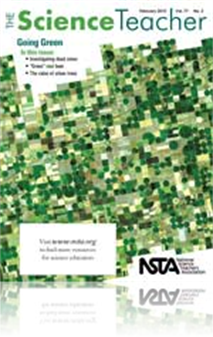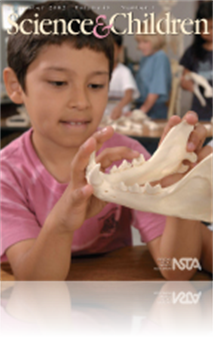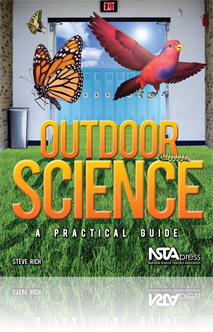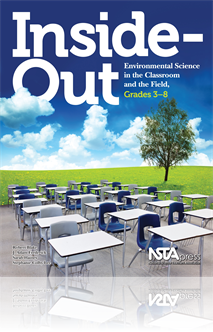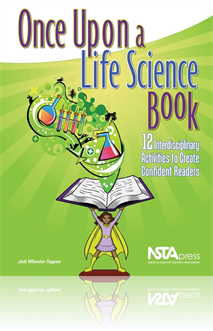All Resources
Book Chapter
This chapter discusses what the United States has long believed are the essentials with regard to teacher compensation: pay, tenure, and the presence or absence of unions in determining teachers' compensation and working conditions. The chapter also ...
NSTA Press Book
Science Education Leadership: Best Practices for the New Century
Achieving science literacy for every student is the common goal of all science educators. It requires leaders from a broad spectrum of the science education field to band together and clearly define how to achieve this goal and provide the tools for ...
Journal Article
This set of lessons is designed to be carried out in all of the subject-area classes. Science lessons are expanded and taught in social studies, math, and language arts classes. This highlights the far-reaching impact that science has on other worldv...
Journal Article
Environmental education “is a process that aims to develop an environmentally literate citizenry” (NAAEE 2004). It is an effective way to engage students of all levels and has improved learning outcomes and achievement in science and other subjec...
Journal Article
What better way to bring students “down to earth” than by studying worms? Worms are inexpensive creatures that can be used to create rich science experiences that relate to the National Science Education Standards. This article describes a succes...
Journal Article
Science 2.0: Create a Classroom Blog!
Science education blogs can serve as powerful digital lab notebooks that contain text, images, and videos. Each blog entry documents a moment in time, but becomes interactive with the addition of readers' comments. Blogs can provide a realistic exper...
Journal Article
The “Green” Root Beer Laboratory
No, your students will not be drinking green root beer for St. Patrick’s Day—this “green” root beer laboratory promotes environmental awareness in the science classroom, and provides a venue for some very sound science content! While many sci...
Journal Article
Science Sampler: Commercial video games in the science classroom
There’s no denying that middle school students are interested in video games. With such motivation present, we as teachers should harness this media in a productive way in our classrooms. Students today are much more technologically advanced than e...
Journal Article
If scientists know where earthquakes are most likely to occur, then architects and engineers can design safer buildings for such areas and potentially prevent some of the devastating aftereffects. Engineers have met this challenge through the design ...
Journal Article
Science 101: Can we protect our communities from natural disasters?
There are two ways one might protect communities from natural disasters. One is to minimize the damage from disasters, and the other is to prevent the disasters in the first place. However, preventing disasters is another matter, and in trying to do ...
Journal Article
Every Day Science Calendar: February 2010
This monthly feature contains facts and challenges for the science explorer. ...
Journal Article
Teacher’s Toolkit: A framework for facilitating equitable discourse in science classrooms
In traditional classroom discourse, the teacher controls the discussion, asking most of the questions and calling on students to respond. This model does not work well for the inquiry-based classroom, which depends on engagement, peer interaction, an...
Journal Article
Science and Literacy: Tools for Life
This article describes three interconnected strategies to help form the structure of support that you and your students can use to reach both goals simultaneously: performance expectations for students, explicit teaching strategies that support inqui...
Journal Article
Idea Bank: The Encyclopedia of Earth
For reliable information on the environment, students and teachers can turn to the Encyclopedia of Earth (EoE). Based at Boston University (BU) and operated in partnership with the National Council for Science and the Environment (NCSE), the EoE is a...
Journal Article
Take plant lessons outdoors with this engaging and inquiry-based activity in which third-grade students learn how to apply soil conservation methods to growing plants. They also collect data and draw conclusions about the effectiveness of their metho...
Journal Article
Editor’s Roundtable: Differentiated instruction to the rescue!
Differentiated Instruction (DI) is an ongoing practice: teachers intentionally and systematically discover and plan lessons around the strengths, needs, prior knowledge, and attitudes of their students. Teachers must routinely consider not just the �...
Journal Article
Career of the Month: An Interview with Food Policy Researcher Caitlin Boon
From safety to nutrition, food policy researchers work to improve what we eat. They examine evidence found by experts in food science, consumer behavior, taste perception, nutrition, and many other related fields. Using this information, these scient...
Journal Article
Editor’s Corner: Why Study Environmental Issues?
There are many compelling reasons to include environmental education (EE) in our science classes. Environmental issues are interdisciplinary—facilitating their inclusion in both physical and life science. They are also complex, providing students w...
Journal Article
Geospatial technologies have emerged over the last 15 years as one of the key tools used by environmental scientists (NRC 2006). In fact, educators have recognized that coupling geospatial technologies with environmental science topics and scientific...
Journal Article
Guest Editorial: Discovering life
In this editorial piece, the author shares how he spent over 20 years as a corporate manager for a financial printing firm. He further explains how bringing a company public or coordinating a corporate merger were difficult tasks, but they were child...
Journal Article
Differentiation Through Choice: Using a Think-Tac-Toe for Science Content
Differentiation can begin with a single lesson, expand to a unit, and finally grow to be a natural part of a teacher’s daily practice. The Think-Tac-Toe, described in this article, can evaluate students’ learning during and at the conclusion of a...
Book Chapter
Birds, Bugs, and Butterflies: Science Lessons for Your Outdoor Classroom
Among the wild animals that may travel through a school yard, birds, bugs, and butterflies are the most common—the focus of most of the lessons in this chapter. It offers a variety of activities to allow you to “tame” the wildlife to help you t...
Book Chapter
The same water that has existed on Earth for millions of years travels through a series of steps in a cycle from mountains to the sea, flows in and out of the cells in your body, and comprises 95% of the mass of a jellyfish. In short, water is the co...
Book Chapter
It is easy for ecology to degenerate into lists of vocabulary words and isolated concepts, leaving students without an appreciation for the complexity of ecological systems. This chapter is designed to help students think about the connections betwee...
Book Chapter
This chapter provides an overview of the book that has everything needed to boost students' science and reading skills. Start by learning about the strategies you need in Chapters 2 and 3, and then dive into the 12 content chapters. As you work throu...
Book Chapter
There are many misconceptions about the urinary system. The misconceptions make it hard for students to understand the critical role of the kidneys. This chapter starts out by having students identify their current ideas about urination and leads the...
Book Chapter
Students often believe that classification is an innate system in nature, discovered whole and unchanged by scientists. In this chapter, students will get a brief introduction to how classification has changed over the years by studying the odd organ...
Book Chapter
The word adaptation, as used in everyday speech, refers to a choice that individuals make to adjust to a new environment. In biology, adaptation refers to changes in populations that result from natural selection. This chapter uses a simulation invol...
Book Chapter
Bacteria: The Good, The Bad, and Getting Rid of the Ugly
Most students think about bacteria primarily in the context of disease. However, bacteria are the most numerous organisms on Earth, and only a fraction of them cause disease. The exploration in this chapter—growing bacteria from the environment—i...
Book Chapter
As mammals that live in the water, whales have been an enigma since the time of Darwin. In the past 20 years, biologists and paleontologists have uncovered a remarkably complete story of whales’ transition from land to water. The evolution of whale...
Book Chapter
Reading strategies can be important for helping students improve reading, but students need something more. They need to begin to view reading as an active search for meaning that is within their control. In this chapter find out how teachers can ch...
Book Chapter
How Do You Know That? Helping Students With Claims and Evidence
Making claims (often called conclusions) and providing evidence are at the heart of the practice of science. Any simple activity that has students focus on making a claim and supporting it with evidence can be used as a starting point for introducing...
Book Chapter
This chapter has two main goals. The first goal is to ease students into the reading procedures described in Chapter 1 by using two reading passages—“On Your Mark!” allows students to practice using the codes to show what they are thinking as t...





